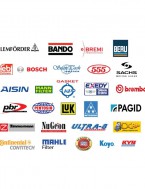
The 2015 K900 and Genesis is a big step forward for the Hyundai Motor Company. Not only because of its superb crash testing performance, but also some key components are all developed by Hyundai itself.
For example the AWD system (called “HTRAC”) are developed in-house, so does the 8-speed transmission. Especially for the 8AT, its design is totally different from the ZF, GM and Aisin units. The Hyundai 8AT uses 4 planetary gear sets and 7 shifting elements (5 clutches, including a one-way clutch and 2 brakes). It is more complicated than any of the other similar units. When compared to the ZF and GM 8AT, it uses more clutches; compared to the Aisin one, it uses one more planetary gear set. Because there are more opened shifting elements in each gear, the Hyundai 8AT is less fuel efficient than the ZF and GM 8AT; with one more planetary gear set, it has more mechanical frictions than the Aisin transmission, which also leads to lower fuel efficiency and drivetrain energy loss.
It appears that from both technical and financial senses, it is stupid for Hyundai to develop the AWD and 8-speed transmission technologies by itself, when it can easily buy them from outside suppliers. But why Hyundai still decides to do this?
This is because Hyundai has a bigger plan, which is about the industry ecosystem in South Korea. Without the support of a full line of supplier companies specialized in different aspects of an automobile, an auto maker cannot run a sustainable business, it even cannot build a car.
Take Germany as example. The reason why most of the best luxury and high performance cars are made by German brands, is not because of names you are familiar with, such as Volkswagen, Mercedes-Benz, BMW. The major factor is because in Europe countries it has first-class auto parts suppliers such as Bosch, ZF, Getrag etc.
For the BMW X1, its manifold, close-coupled converter, interior trim, front-end parts (including bumpers) are all supplied by Faurecia (a company specialized in Seating, emissions control technologies, interior systems, exteriors); The 8-speed transmission is sourced from ZF (a company famous for its automatic transmissions); The lighting system is from Valeo. The list can keep going on if you wish to research. In fact, using the below document (excerpt from Automotive News), which shows the top 100 global OEM parts suppliers, you can find almost every famous car brand is heavily rely on those OEM companies.
2012 Global Top 100 OEM Parts Suppliers
So you may wonder what is the role of an automaker such as Toyota, Volkswagen? The automaker designs the car, and set the requirements for each component. But they may not have the knowledge and technology to realize it, so here comes the suppliers. For example you need an transmission that has 9 speeds, and can shift within 0.2 seconds. You can ask specialist such as ZF, Aisin to see whether they have a suitable product to supply to you; if they do not have, you can ask them to develop one for you if you can work out the cost.
Below is a list shows the suppliers of various key components in some famous cars.
1. VW DSG double clutch transmission – developed by BorgWarner;
2. VTG turbocharger used in Porsche 911 – developed by BorgWarner;
3. Root-type superchargers used in the current Audi and Jaguar fuel direct injection engines – supplied by Eaton;
4. Torsen limited-slip differential – made by JTEKT, a company owned by Toyota;
5. Magnetically controlled adaptive dampers (MagneRide) used in Ferrari 599 GTB, and many Audi models – developed by Delphi;
6. Electromagnetic clutch system in Acura’s SH-AWD – developed by BorgWarner;
7. Plasma-sprayed technology for cylinder bores used in Nissan GT-R’s VR38DETT engine – developed by Flame-Spray Industries;
8. Bugatti Veyron’s 7-speed transmission – made by Ricardo;
9. Nissan GT-R’s 6-speed double clutch transmission – designed by BorgWarner, build by Aichi Machine Industry;
9. Limited-slip differential, central coupler in Nissan GT-R – made by GKN
10. Torque-sensing front limited-slip differential in Honda Civic Type-R – supplied by Quaife;
11. Engine cylinder block in Koenigsegg CCXR – produced by Grainger & Worrall (an UK metal casting company with F1 experience in drivetrain components)
You can see, a country’s automobile industry does not mean several car makers only, in fact the most important members are the parts suppliers, specialized in various technologies. Those several famous car brands that known to many people, are just the tip of the iceberg.
For Hyundai, it is a South Korean company. The management knows because of the country’s special geographic location and the markets the company are operating with, requires a full localized automotive industry ecosystem to support the Hyundai/Kia brand. This is the reason why the HTRAC and 8AT costs lots of money to develop and may not perform better than products from foreign suppliers, but Hyundai still choose to go with this route. It is not for short term profit, but with long term vision.



Recent Comments